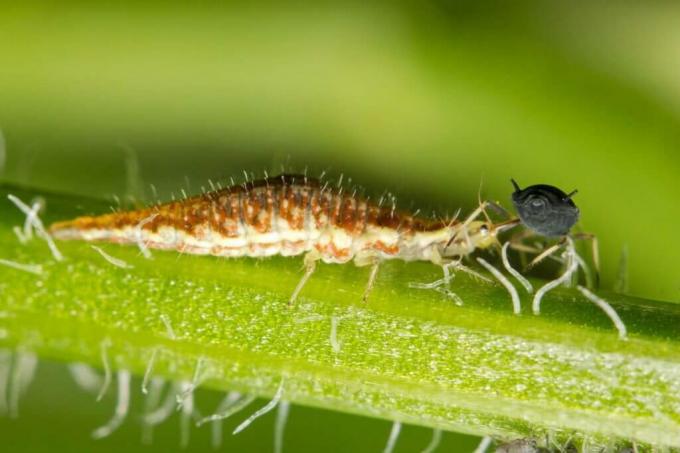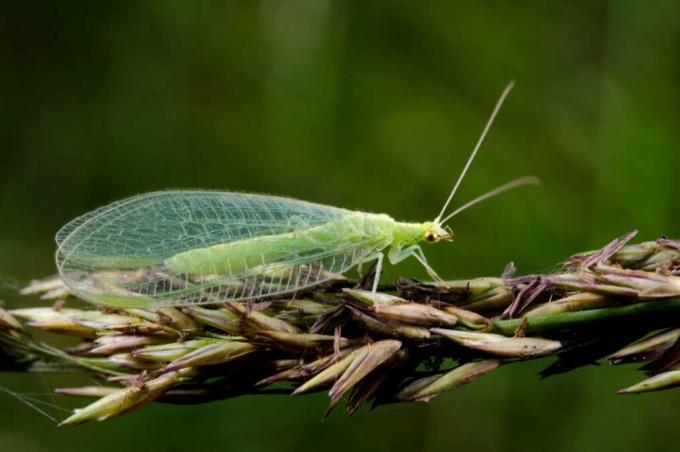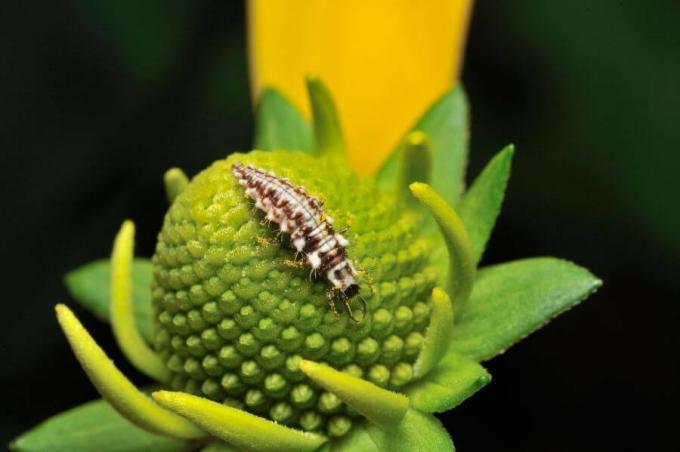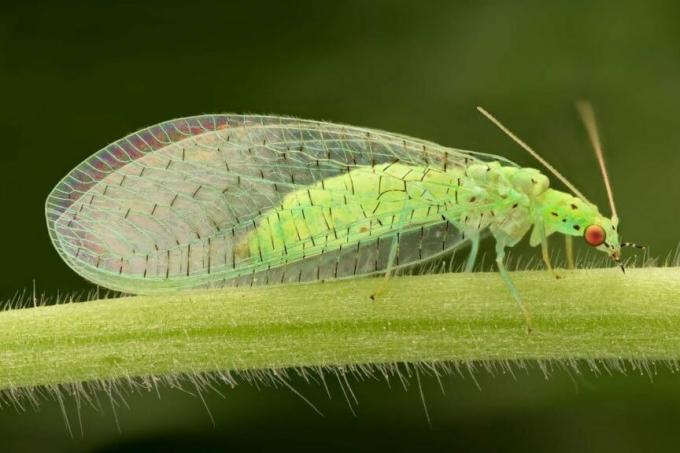Lacewing and lacewing larvae can be used for the natural control of pests such as aphids and the like. We introduce the beneficial organism and give tips on how to use lace flies.

The common lacewing (Chrysoperla carneaAs a beneficial insect against aphids, thrips and spider mites, it is the most important species of lacewing (Chrysopidae) for us. The adult lacewings have earned the name "golden eyes" due to their shimmering compound eyes. They are greenish in color and have net-like pairs of wings. The voracious larvae are also nicknamed "aphid lions" because they can eat up to 50 aphids per day or up to 800 aphids during their lifetime.
contents
- Lacewing: Wanted poster
- Lacewing larvae as biological plant protection
- Is the lacewing bite dangerous?
- Lacewing in the apartment
- Promote lacewing in the garden
Lacewing: Wanted poster
Lacewings are particularly common at dusk or at night. They feed mainly on pollen and nectar, but honeydew (i.e. excretions from aphids) is also on their menu. A female can lay 100 to 900 eggs. A special feature when laying eggs are the long ice stalks on which the lacewing lays its oval eggs. This also always happens in groups near aphid colonies.
When the larvae hatch, they molt first and then migrate downwards in search of a suitable food source. For example, when they find an aphid, they grab it with their pincer-like mouthparts and suck it out.
Depending on the weather, the larvae take 8 to 22 days to develop into an adult. Temperatures of 20 to 26 ° C are ideal for development. In contrast to many other beneficial insects, lace flies are already active from 12 ° C. The menu includes aphids (Aphidoidea), thrips (Thysanoptera), spider mites (Tetranychidae), mealybugs (Pseudococcidae) or whiteflies (Aleurodes proletella or Trialeurodes vaporariorum). If the food supply is not large enough, it can also happen that the larvae dare to approach larger prey such as ladybird larvae or even conspecifics.

Lacewing larvae as biological plant protection
With these special larvae you can pest your beloved garden or house plants Get rid of it without worrying about the effects of chemical insecticides. In the greenhouse or living room, the animals cannot migrate so quickly and are particularly effective here. However, it is not possible to preserve the lacewing for a long time. Therefore, a new use of beneficial insects is necessary after about two weeks if the infestation has not been controlled by then. In the wild, the animals have the opportunity to migrate, which somewhat reduces the short-term effect, but lacewings can also settle in your garden in the long term.
Even if lace-fly larvae target aphids in particular, they can be used sensibly for many pests, for example:
- Aphids
- Mealybugs
- Mealybugs
- Thrips
- Spider mites
- Whiteflies
Lacewing can be used indoors all year round. Outdoors it has to have a minimum temperature of 15 ° C (whereby the night temperatures can be 8 ° C) in order to be successful. All you have to do is deploy the lacewings and the larvae will do the rest of the work on their own.
You can order the eggs or larvae in various pack sizes over the Internet in online shops, for example from nuetzlinge.de. You can buy lacewing eggs as scattered goods, but there is also the option of placing the larvae on cardboard strips and simply laying them out on the infested plants.

Lacewing is delivered at an early stage of development, so you shouldn't be surprised if you do when pulling the paper strip off the cardboard box or in the grit, can only see little or no movement - that's all normal.
The variant with the cardboard strips is particularly suitable for a light or medium infestation with pests and is very easy to use. Eggs on long stalks are glued to the carton and placed in the shade near the infestation. The larvae, on the other hand, are in cardboard honeycombs that are covered with a strip of paper. A larva sits in each honeycomb so that the voracious predators don't eat each other. After delivery, you should expose the larvae to the infested plants immediately, preferably in the evening or in the morning - the nocturnal animals do not like direct sunlight.
How to use the cardboard strips:
- Do not remove the paper strip until you reach the plants.
- Hold the strip over the plants and let the larvae fall out by tapping them gently.
- Let the strip sit with the plants in the garden for a few days. It is possible that a few lacewing larvae are still sitting in the combs and still migrate into the population.
How to use the litter:
- Open the bag on the plants and first carefully mix the husks with the lacewing larvae.
- Then sprinkle the entire contents as evenly as possible.
- Leave the bag in the herd for a few days so that even the last larvae can crawl out.
Note: The targeted use of beneficial insects is often not sufficient, especially in the case of a stronger infestation or unfavorable conditions for the beneficial insects. In these cases, we recommend using a biological pesticide.
A biological alternative to pest control with beneficial insects are preparations based on neem oil. The seeds of the neem tree contain a valuable oil with the active ingredient azadirachtin. This natural active ingredient is excellent for combating pests such as aphids, whiteflies, spider mites and cicadas. Our Plantura organic pest-free neem is based on this effective neem oil and enables biological pest control. You can use the purely herbal product both indoors and outdoors. Although our organic pest-free neem can be used against a variety of biting and stinging plant pests, it is not dangerous to bees. The active ingredient from the neem oil is absorbed by the insects and causes a quick stop of feeding and sucking. Since the insect larvae no longer develop properly, the pests die off completely. Our Organic pest-free neem can simply be mixed with water to form an emulsion and sprayed onto the infected plant. Please use organic pest-free Neem exactly as specified in the application recommendation and read the package insert before use.
In general, you should refrain from using any pesticides if you have decided to use lacewings, as these can harm the beneficial insects.
Is the lacewing bite dangerous?
Lacewing larvae may look a little frightening from close-ups in pictures, but they are completely harmless to us humans. The lacewing larvae bite is therefore not dangerous. The adult animals and their larvae do not see us humans as prey and can therefore be observed without danger.
Lacewing in the apartment
Since our beneficial insects want to get over the winter safely, it can happen that lacewings are found in your own four walls. Of the around 35 different lacewing species in Central Europe, the common lacewing overwinters as adult animal in frost-free areas outdoors or looking for a suitable hiding place in the Inner space. Many other lacewing species overwinter in a cocoon as a prepupa.
Since lacewings are very useful to us, they should not be controlled. It can happen that they are lured out of their winter hiding spots by light and fly around a bit, but the lacewing will soon find a cozy hiding place again. They especially like to hide behind pictures or in the attic. They generally prefer cooler rooms such as attics and garages for wintering.
Let the lacewings hibernate with you, because the small creatures do not cause any damage and will help you with unloved pests in the home garden in spring. In the spring, open the windows to make it easier for the lacewings to leave their winter hiding spots. Then all you need to do is enjoy your beneficial insects in the garden.

Promote lacewing in the garden
You can even set up the lacewings in a targeted manner using a lacewing box in the garden. You can buy it or just build it yourself. Most hatcheries are only made of wood and are filled with straw or wood wool, in which the lacewings can wrap themselves up. So that nothing oozes out, you can still attach a coarse wire or some wooden strips. Since the color red seems to be very attractive to our lacewings, it is advisable to paint the boxes in this color and to set them up in the garden between the plants. With a blooming meadow of flowers in your garden, you can also encourage beneficial organisms such as the lacewing. Our Plantura beneficial insect magnet is a seed mix that makes it easy for you to attract beneficial insects.
Exciting tips too Beneficial organisms in the garden we have compiled for you in our special article. You can find more biological pesticides against a large number of different pests in our shop for Plant protection & insect repellent.



